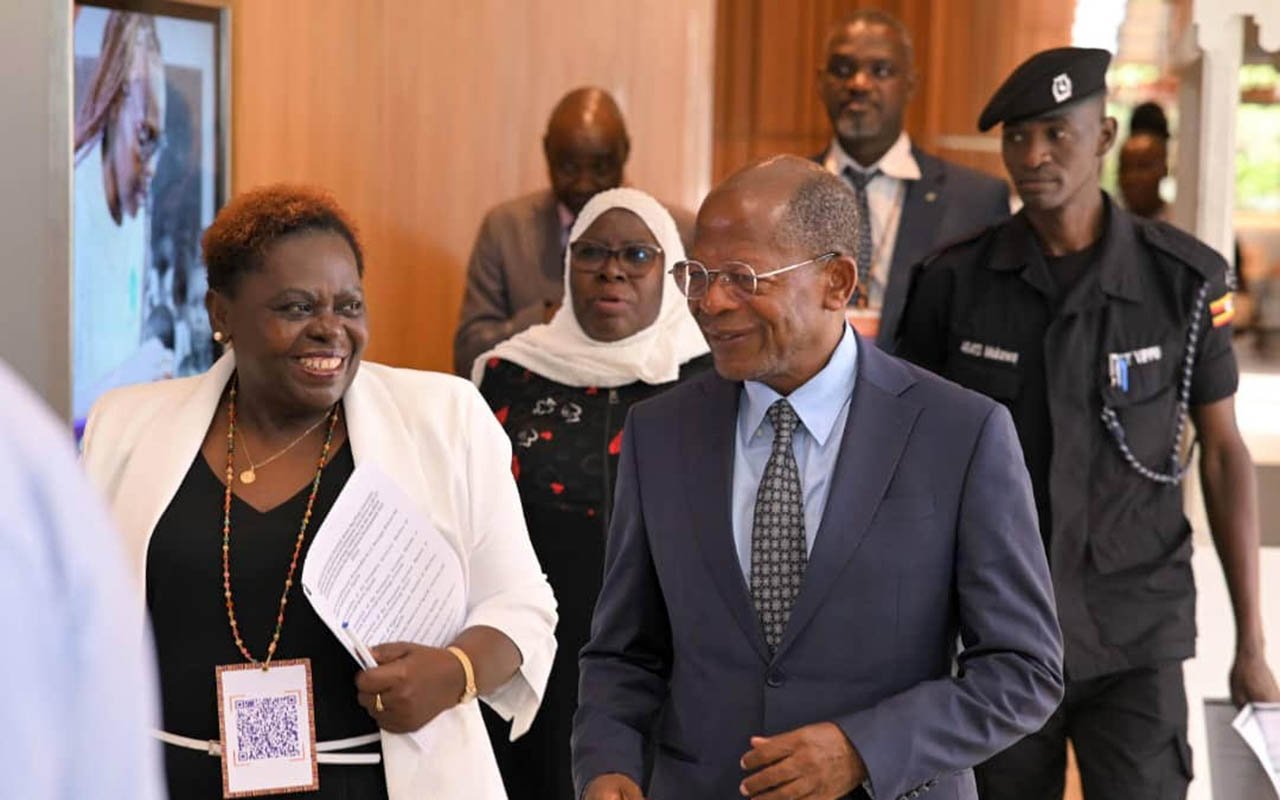Police report shows no progress in crime fight over10 years

Killed. The scene where former Arua MP Ibrahim Abiriga and his younger brother Saidi Kongo were shot dead in Kawanda, Wakiso District, in June. FILE PHOTO
What you need to know:
Prevention. Although police have been bragging about taking services nearer to the people, statistics show the Force is, in most cases, unable to stop crime before it happens.
The Uganda Police Force continues to post a poor performance in the crime fight despite an increase of its budget from double digit to triple digits 10 years down the road, with the hopes of apprehending and bringing criminals to book fading every passing year.
Compared to 2007, the crime trend shows that police continue to lose the fight to criminals, with districts formerly ranked very low in the commission of crime now ranking high in the same.
Although police has been bragging about taking services nearer to the people, statistics show the Force is, in most cases, unable to stop crime before it happens. Last year, police registered a total of 252,065 cases compared to 119,072 10 years ago in 2007.
Prosecution
During the year under review, police only managed to investigate and take to court a quarter (66,526) of the reported cases where 77,675 suspects were charged. Of the cases taken to court, police only managed to provide evidence linking criminals to the crime in 1,419 cases, where they secured a conviction.
Police failed to investigate and bring evidence in 9,613 cases and they were accordingly dismissed. A total of 105,017 cases are still under inquiry, while 36,633 cases are still pending in court.
Districts such as Lira with 7,872 cases, Ntungamo (6,839) Mbarara (5,096) and Gulu (4,741) that were unheard of in the crime fight 10 years ago are now leading in the commission of crime.
Katwe Police Division that had the highest number of reported cases in 2007, with 4,160 cases, has been pushed to the 14th position.
On average, there were 12,831 cases reported to police every month in 2007 compared to 21,005 cases reported to police in 2017.
A close look at specific crimes shows that in 2007, police received 1,927 cases of murder. Ten years later, the same cases have jumped to 4,473. Districts such as Mukono that recorded the highest number of homicide cases with 79 in 2007, followed by Bushenyi (74), Mbale (74), Sironko (72) and Masaka (69), have been overtaken by other districts.
However, the latest crime statistics show that homicide cases have shifted to hitherto unheard of districts of Kiryandongo.
Kiryandongo recorded the highest cases of murder in the country last year, with 116 cases, followed by Mbarara (107), Luweero ((93), Mbale (86), Kyenjojo (75) and Hoima (70).
Unfortunately, the shift in murder cases from one area to another has not been followed by an appropriate detection rate.
In 2017, there were 4,473 cases of murder registered at police. Of these, there were 167 people who were killed by shooting.
However, the police only managed to investigate and take to court 53 cases, out of which it secured only three convictions. Two other cases were dismissed for lack of evidence, leaving 47 cases pending in court.
During the year under review, police had some of their own gunned down on March 13, 2017, but are yet to convincingly arrest and charge the suspects in the murder of the former Force’s spokesperson Andrew Felix Kaweesi and his lieutenants.
Police continues to face the same challenge of mob action it had 10 year ago. Death by mob action has jumped from 184 cases in 2007 to 603 in 2017.
Police has paid little attention to fighting domestic violence, pushing the cases from 156 cases in 2007 to 361 cases in 2017. By the end of 2017, only 191 cases of domestic violence had been investigated and taken to court, and police secured only seven convictions and lost two cases. A total of 181 cases are still pending in court, further dampening hopes of bringing errant spouses to book.
Though police have continuously portrayed themselves as the best equipped to fight terrorism in the region, their performance in detection of cases of terrorism is still wanting.
In 2007, 12 cases of terrorism were registered at police, with a similar number in 2017. At the close of the year, police had taken three cases to court and they were still pending there by close of year. Six of the cases were under inquiry.
In 2007, police reported 12,230 cases of defilement. The number has since jumped to 14,985. Defilement was ranked the third overall crime committed last years after common assaults, (30,794) in first position and domestic violence (15,325) in second.
Rape cases jumped from 599 cases in 2007 to 1,335 in 2017. Last year, a total of 396 cases of rape were taken to court but police only secured convictions in six cases. In the whole of 2017, police only secured one rape conviction, leaving other sex predators to roam the country freely.
Although police launched an operation to get rid of gun crime through the work of the Violent Crime Crack Unit, 10 years later, police still has a long way to go in curbing gun crime.
In 2007, police recorded 5,666 robbery cases compared to 6,850 in 2017.
Ten years later robbery of motor vehicles continues to pose a challenged to the Force. There were 66 cases of robbery of motor vehicles reported to police, 386 cases of robbery of motorcycles and 487 cases of robbery of cash.
Robbers have moved their targets from Kira Road Police Division, Jinja Road and Kampala where their focus was 10 years ago to the districts of Lira, Mbarara, Arua, Ntungamo and Kabale districts, among others.
However, robbers have not changed their focus from robbery of motor vehicles, motorcycles and cash. Despite the increase of police numbers, the Force secured only three robbery convictions.
Economic crimes remain a challenge to the police, with obtaining money by false pretence, forgery and uttering of false documents, counterfeiting, issuing false cheques, and embezzlement taking the largest share.
There were 9,978 economic crimes reported to police in 2007, a number that has almost doubled in 2017, with 16,031 cases.
A closer look at police performance in regard to specific crimes shows dismal performance in detection of crime.
The same poor rate of conviction can be seen in crimes such as domestic violence, threatening violence, common assaults, burglary and thefts of all forms, including of mobile phones.
Unlike other crimes, police seems to be on top of kidnap cases where they secured an almost 90 per cent rescue rate.
Out of the 211 cases of abduction reported, police rescued victims in 191 cases and only 22 victims still missing by close of year.
Like a poor workman, the Uganda Police Force comfortably continues to blame their tools for their failure to apprehend criminals. Ten years ago, police blamed its poor performance on inadequate training, shortage of experts such as ballistics, handwriting experts and lack of modern equipment for investigations. Police have since shifted and wants all roads fixed with street cameras.
Although a lot of measures have been floated in the last 10 years, like case-conferencing, supervision and monitoring investigators and computerisation of crime records from headquarters to stations, most of these have only remained on paper.




